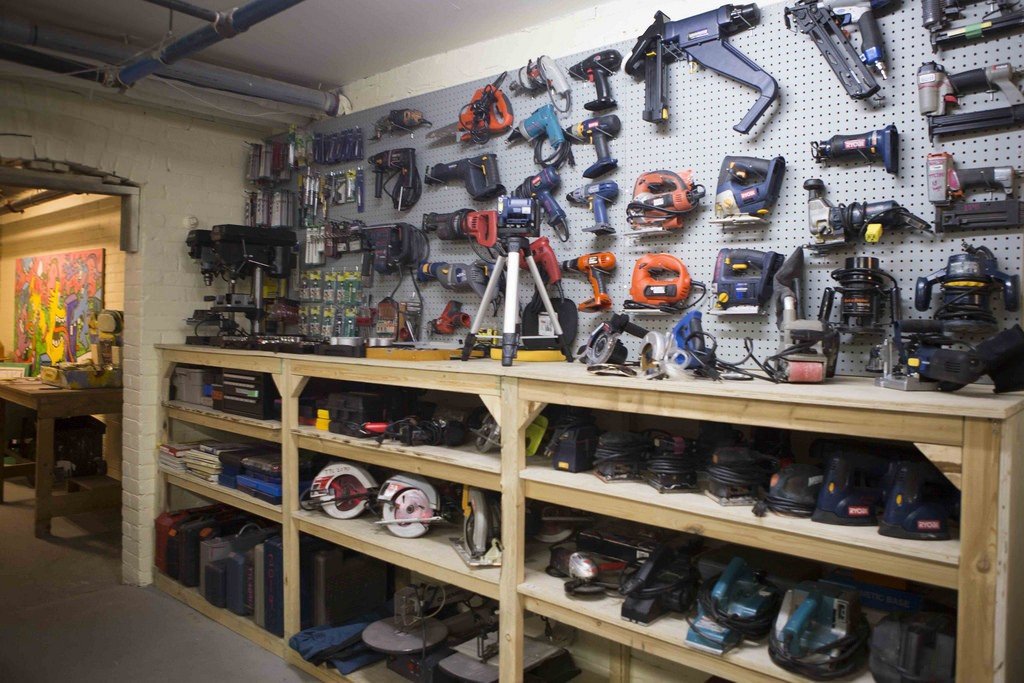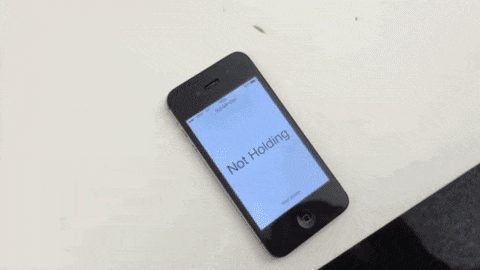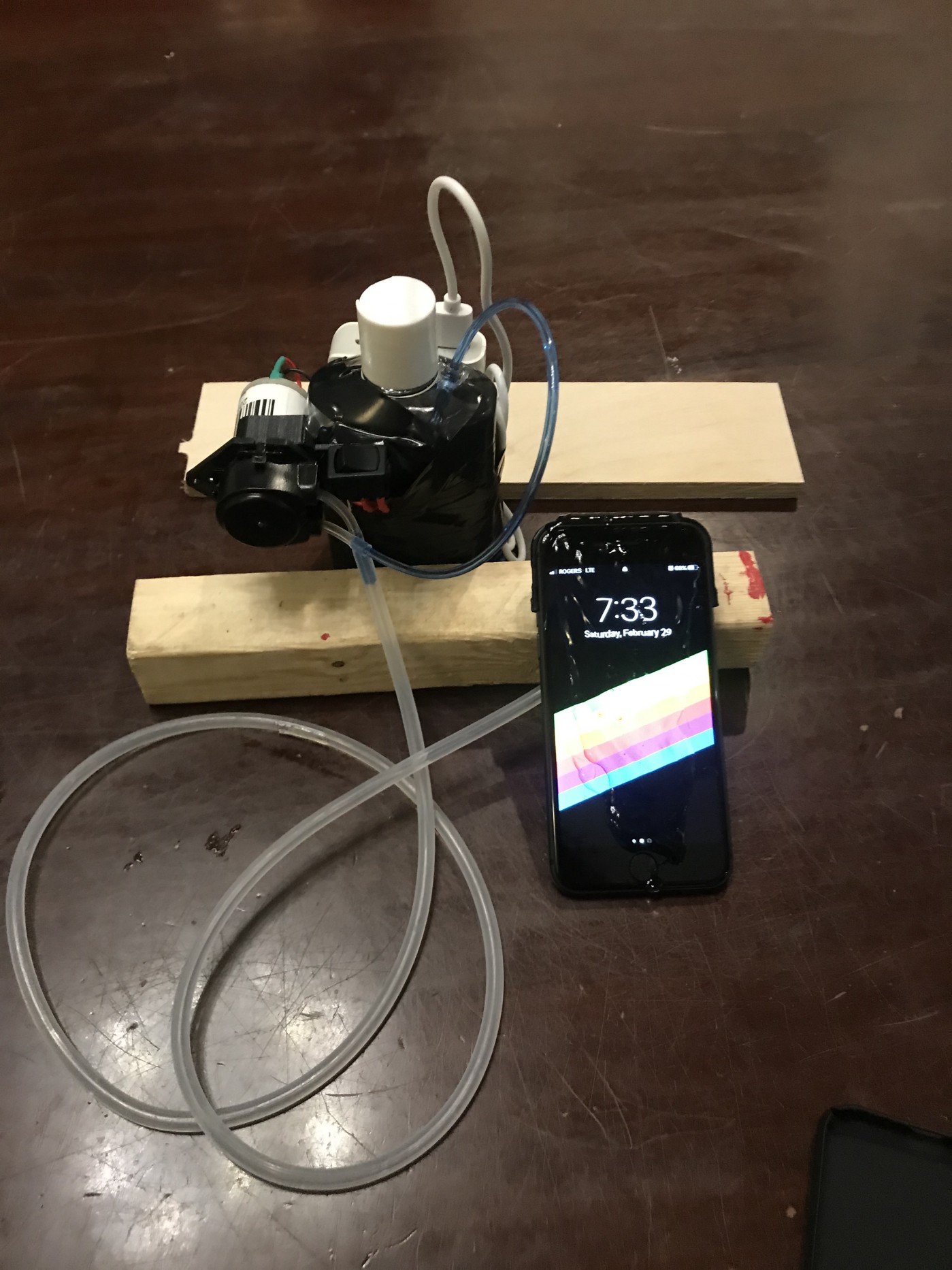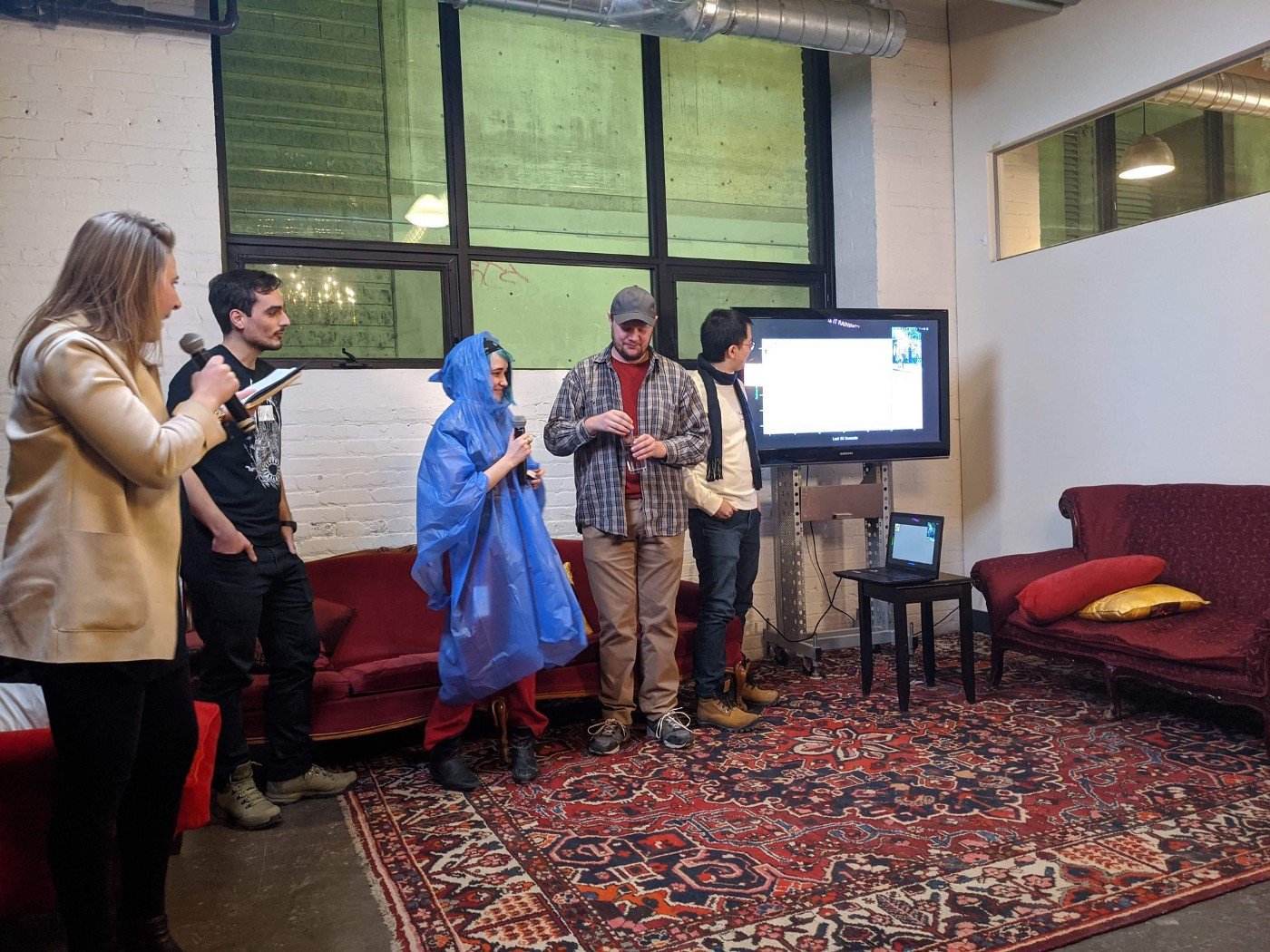STUPID HACKATHON: HAND-SANITIZING OOZING PHONE
Damp Technology: The Oozing Hand-Sanitizing Phone Case. Our final project.
The ‘Stupid Hackathon’ was held over two days at the Toronto Tool Library, which is literally a library for tools (and also a maker space, woodshop, seed library, and more)! The event was put together by Toronto-based creative technologies and researchers — with interests in creative technology, fabrication, and sustainability.
Inside the Toronto Tool Library
For a little context, the original ‘Stupid Hackathon’ was created in 2004 by Sam Lavigne & Amelia Winger-Bearskin and hosted at NYU’s ITP program. The principles and ethos of the hackathon are pretty simple — rapidly make stupid tech with strangers or friends and then present it to the audience in a fake startup-like setting.
I met with Sam a few years ago to talk to him about the origin of the Stupid Hackathon. (I was conducting research at Carnegie Mellon on the utility of humor to critique emerging technologies.) During our meeting, Sam told me that the Stupid Hackathon was designed in part as resistance against the rise of corporate-sponsored hackathons in academic settings. Questioning the dubious nature of corporations leveraging unpaid student labor to generate intellectual property during hackathon-fever was ahead of its time.
The structure of the event mirrors a corporate-sponsored hackathon that concludes with a pitch to fake venture capitalists (Shark-Tank style, or Dragon’s Den style if you’re in Canada). The projects made by Stupid Hackers are often satirical and critical of capitalism, technology’s impact on society, culture, and the environment. One of my favorite Stupid Hackathon (2014) projects — Holdr, by Sam Tarakajian — is an app called that tells you if you are currently holding your phone and perfectly illustrates the energy of the hackathons.
Holdr demonstration. Project by Sam Tarakajian
The Holdr project is absolutely ridiculous. Of course, you already know if you’re holding your phone — how absurd! Yet, this project is successful on a variety of levels. Holdr is stupid shit nobody needs, yes! It also incisively critiques the thousands of ‘legitimate’ apps and IoT devices that perform specific and perhaps unnecessary tasks for us at great economic and environmental costs — see the Kickstarter project- Candle Touch, an IoT candle. (For a full list of my favorite Stupid Hackathon projects, wait like a day. I’m writing a Twitter thread about that tomorrow)
For years, I’ve been thinking about how humor, broadly, and satire, in particular, can be leveraged to make us all more critical about technology and its impact. During graduate school, I hosted a lot of conversations with diverse folks about their relationships with emerging technologies such as smartphones, IoT devices, autonomous vehicles, and more. In general, many of the folks I spoke with viewed technology as a gift — a modern marvel! Ye, with the rise of mass surveillance, biased machine learning impacting so many sectors, and updated understandings of the ecological toll caused by technology manufacturing, supporting critical explorations of tech is more crucial than ever before.
Now to the fun part: damp technologies: oozing phones, internet-enabled pants, and the friends we made along the way!
I didn’t have a team or an idea before coming to the Stupid Hackathon Toronto. I only knew that I wanted to see one of these events in action, and I wanted to create something tangible, versus a website, Twitterbot, or app. Though, Endless.horse, is probably the most genius Stupid Hackathon project ever made. Maybe, I just realized that there was no way to compete with that project…. (see beloooooow).
Endless.horse — Users scroll to see the endless horse legs.
My team came together almost instantly. On Friday night, the first night of the hackathon, I immediately reconnected with an old friend — Daniel Tempkin of Esoteric Codes fame, and we sat with two nice engineering-oriented folks — Alex Warner and Kyle Chisholm. We cracked a couple of jokes about the subtle brilliance of the Soylent for Women, a Stupid Hackathon project from a few years prior, and that was it. That was our team.
Later, we attended Sagan Yee’s workshop on Twitter bots, where she told us about her project (with Rachel Lane) from a previous year called Preg or Neg, whereby you pee on your phone, and it tells you if you’re pregnant. We were thrilled by the concept and used it to springboard our own ideas.
My team was eager to think of technologies that required you to maybe (slash definitely) destroy your phone during use because that would be quintessentially useless.
Early in our brainstorming session, we arrived at the concept of damp technologies. The comedy lies, for us, in the idea of introducing moisture to a technology we’ve been trained to protect from water at all costs. Who amongst us hasn’t sprinted to the store to grab rice in an attempt to salvage our phone from a damp demise?
Damp phone ideation session captured.
After an initial brainstorming session, we decided we wanted to build a damp phone that reflects the cultural moment, we decided to develop a case that oozes hand sanitizer to reduce the transmission of coronavirus from hands to face via phone (apparently, a real threat — be careful out there!). And since everyone at this moment is concerned about Coronavirus / Covid19 , we thought we’d leverage that anxiety (which we also shared) and general reticence to get one’s phone wet for humorous effect. (This is all very high-minded. We basically spit-balled ideas until we were laughing with tears and worked backward from there.)
The next day, we built the oozing contraption. Our teammate Alex Warner 3D printed a phone case that could be fitted with tubing to facilitate the oozing. We borrowed a peristaltic pump (these are amazing!) to facilitate the movement of the hand-sanitizer from a bottle up into the phone case and out of the front attachment. Alex and Kyle leveraged their engineering skills to add a switch and figured out the proper voltage needed to move the viscous liquid through the tubing and out of the top of the phone case (to better ooze down the phone). It all came together in a matter of hours. In fact, the most time-consuming part of the process was sourcing the hand-sanitizer since so many shops were sold out.
Work-in-progress photograph of the hand-sanitizing pump
In order to make our pitch to the “VCs” and Stupid Hackathon audience more compelling, we put together a pitch deck and called our company DAMP Technologies. In case you’re wondering, DAMP is an acronym, standing for Damp technologies And Mobile Pants (an homage to stupid acronyms in SV).
Here, I should mention that we also developed speculative network-enabled pants with features such as conference calling (you must shout into your own glowing Neopixel crotch for it to work well), crotch-recognition technology (only your crotch can unlock the pants), and a booty-bump to add colleagues on LinkedIn (these are business pants, after-all).
DAMP TECHNOLOGIES INC. — see Mobile Pants in action.
It was a joy to develop that slide-deck and do a live demonstration of the DAMP Phone aka Hand-Sanitizing Phone Case and the DAMP Pants for the audience (we included lots of Steve Ballmer-like shouts). We were all in tears by the end. I enjoyed the other projects, which included She-Bangs — a bot that tells you whether you should get bangs (it’s always a “no”); a helmet that directs you to the Dufferin Mall in Toronto, which I take has seen better days; a raincoat that tells you when it’s raining; and finally, sneakers that loudly shout your step-count to inform other about how much exercise you’re getting (I love the braggadocio!). I’ll link to those projects, once the Stupid Hackathon-Toronto updates their site.
A super great hackathon project: Ponch-No. Let your poncho tell you whether or not it’s raining!
After experiencing my first Stupid Hackathon, I’ve doubled down on my belief that we must create more spaces and experiences that allow diverse folks to converge and challenge expectations around technology. This is a crucial moment for society to ask technology companies to be more responsible for how their decisions will affect the future generations in regards to civil liberties, the ecological toll of irresponsible technology development (#rightToRepair), the economic consequences of automation… I could go on and on.
Stupid Hackathons leverage humor to create social spaces where it’s safe to push back against capitalism-induced fantasies of technology’s capacity, its leaders, and its pervasive culture of unquestioned positive will. I’m looking forward to my next Stupid Hackathon, and I hope you feel inspired to go out and make the stupidest shit imaginable. Society will benefit from it!
Thank you to my Stupid Hackathon collaborators: Daniel Tempkin, Alex Warner, Kyle Chisholm.ca, and thank you to the organizers of the event!







